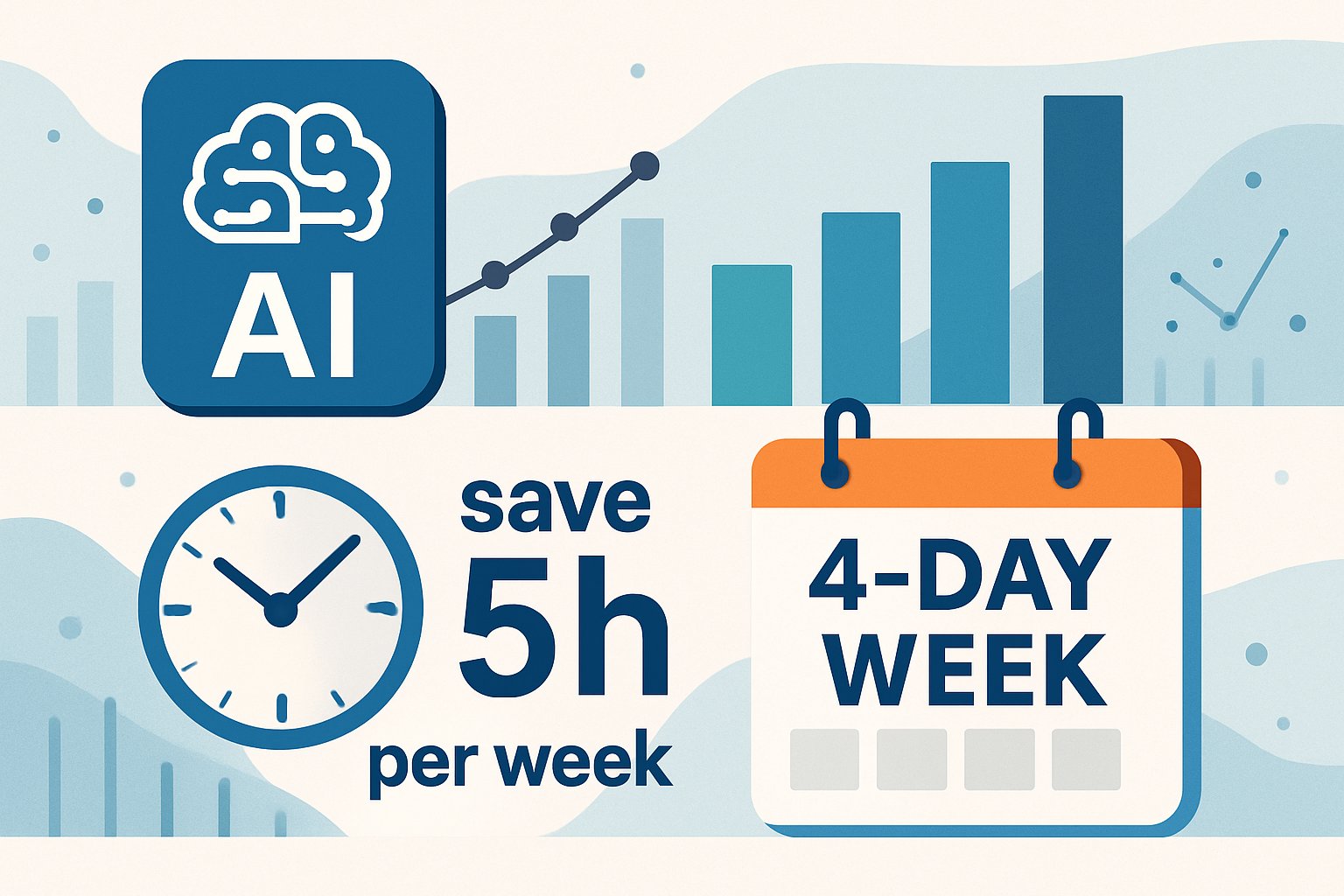
AI CERTS
2 hours ago
AI and four-day week: workforce transformation research insights
This article dissects the numbers, projections, and caveats behind the emerging 32-hour conversation. Readers gain actionable insights on automation efficiency gains, HR policy implications, and employee wellbeing focus. Prepare for a balanced exploration grounded in evidence and strategic context.
Generative AI Time Reality
Surveys show early adopters reclaim about 2.2 hours each week using generative assistants. Moreover, the St. Louis Fed links that figure to a 1.1 percent productivity lift. Nevertheless, the gain equals only one quarter of the 20 percent jump needed to sustain a 32-hour schedule with full pay. Workforce transformation research therefore stresses the difference between individual convenience and enterprise-wide redesign. Many organisations still chase low-hanging automation efficiency gains in email triage and meeting summaries.

Analysts caution against overreliance on self-reported metrics. In contrast, objective workflow studies remain scarce and often industry specific. HR policy implications also emerge because uneven adoption can widen wage gaps between knowledge and frontline staff. These realities highlight present limitations.
Generative tools deliver measurable but insufficient savings. However, larger benefits may emerge when workflows and incentives evolve, setting the stage for pilot evidence.
Pilot Programs Show Promise
Coordinated pilots across six continents offer richer evidence. Furthermore, 92 percent of firms in 4 Day Week Global trials kept the shorter schedule after completion. Autonomy’s evaluation of the Scottish government pilot recorded a 25 percent drop in psychological sick leave. Employee wellbeing focus appears central to sustained success.
Many programs follow the 100-80-100™ model. Companies maintain pay and output while trimming hours through ruthless meeting pruning and smarter tooling. Automation efficiency gains help but are always paired with clear performance metrics.
- 35 percent average revenue improvement reported in selected trials
- Significant reductions in absenteeism and turnover across cohorts
- High recruitment appeal among sought-after digital talent
These numbers energise media narratives. Nevertheless, sample sizes remain small and often technology-centric. Pilot evidence suggests feasibility with disciplined management. Consequently, attention shifts to the gap between aspiration and economy-wide productivity.
Productivity Gap Still Looms
The productivity paradox resurfaces when pilot optimism meets macroeconomic math. Consequently, McKinsey scenarios estimate that only 30 percent of current hours might be automated by 2030. That figure still trails the threshold for a universal four-day norm. Workforce transformation research therefore quantifies a sizeable shortfall despite headline-grabbing trials.
In contrast, Autonomy modelling projects 28 percent of workers could reach 32-hour weeks by 2033 under optimistic capture rates. However, projections hinge on broad distribution of automation efficiency gains. The productivity paradox intensifies if firms channel AI savings into additional output rather than shorter hours.
Measured gains remain smaller than required. Yet leaders can narrow the gap through deliberate policy, which directs focus toward organisational levers.
Policy And HR Levers
Regulation will shape whether AI benefits translate into leisure or layoffs. Moreover, proposed 32-Hour Workweek legislation and collective bargaining clauses already reference HR policy implications. Unions lobby for safeguards ensuring employee wellbeing focus alongside technology rollouts.
Strategic upskilling also matters. Professionals can enhance their expertise with the AI+ Human Resources™ certification. Consequently, HR leaders gain tools to measure time use, redesign roles, and document automation efficiency gains.
Sound governance aligns incentives around reduced hours rather than head-count cuts. Therefore, policy frameworks will likely decide AI’s societal dividend. These levers intersect with sector-specific realities.
Sectoral Winners And Laggards
Knowledge-intensive fields such as legal services and marketing enjoy immediate AI boosts. Meanwhile, hospitality and logistics remain constrained by physical tasks. Workforce transformation research reveals stark contrasts in time-saving potential.
Moreover, employee wellbeing focus differs across sectors. Office staff savour extra recovery days, whereas shift workers often crave predictable rosters first. HR policy implications must therefore address sectoral diversity while mitigating the productivity paradox.
Sectors with high digital content stand closest to 32-hour feasibility. Conversely, manual industries require complementary robotics before hour reductions appear viable. Understanding this split informs strategic planning.
Sectoral analysis underscores uneven readiness. However, leaders can still craft phased roadmaps tailored to local constraints.
Strategic Roadmap For Leaders
Executives should start with granular time-in-motion studies. Subsequently, they can target high-volume tasks for quick automation efficiency gains. Cross-functional pilots then test output stability under shorter hours.
Data transparency remains vital. Therefore, dashboards tracking wellbeing, turnover, and productivity paradox indicators enable rapid course corrections. HR policy implications surface early when compensation structures conflict with newly freed time.
Finally, change management campaigns sustain momentum. Employee wellbeing focus strengthens adoption by framing AI as ally, not threat. Workforce transformation research recommends iterative scaling rather than overnight mandates.
Roadmaps convert theory into practice. Consequently, organisations position themselves for durable competitive advantage.
Conclusion And Next Steps
Evidence confirms that generative AI already saves time, yet the gains remain incremental. Nevertheless, coordinated pilots demonstrate that disciplined processes and supportive policies can stretch those savings into shorter workweeks. Workforce transformation research continues charting pathways that balance automation efficiency gains, HR policy implications, employee wellbeing focus, and the persistent productivity paradox. Leaders should engage with data, pursue targeted pilots, and invest in human-centric certifications. Therefore, explore advanced learning programs and begin designing your four-day future today.



